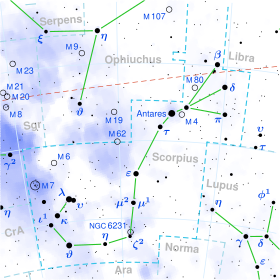Lambda Scorpii is a triple star system and the second-brightest object in the constellation of Scorpius. It is formally named Shaula; Lambda Scorpii is its Bayer designation, which is Latinised from λ Scorpii and abbreviated Lambda Sco or λ Sco. With an apparent visual magnitude of 1.62, it is one of the brightest stars in the night sky.
Nomenclature
λ Scorpii (Latinised to Lambda Scorpii) is the star system's Bayer designation.
It bore the traditional name Shaula, which comes from the Arabic الشولاء al-šawlā´ meaning 'the raised [tail]', as it is found in the tail of Scorpius, the scorpion. In 2016, the International Astronomical Union organized a Working Group on Star Names (WGSN)[12] to catalog and standardize proper names for stars. The WGSN's first bulletin of July 2016[13] included a table of the first two batches of names approved by the WGSN, which included Shaula for the star λ Scorpii Aa.
In Indian Astronomy it is called MulA Nakshathram. Mūla ("root") (Devanagari मूल/मूळ) (Tamil: மூலம்) is the 19th nakshatra or "lunar mansion" in Vedic astrology. The symbol of Mula is a bunch of roots tied together (reticulated roots) or an 'elephant goad' (ankusha).[citation needed]
In Chinese, 尾宿 (Wěi Xiù), meaning Tail, refers to an asterism consisting of λ Scorpii, ε Scorpii, ζ1 Scorpii, ζ2 Scorpii, η Scorpii, θ Scorpii, ι1 Scorpii, ι2 Scorpii, κ Scorpii, μ1 Scorpii, and υ Scorpii.[14] Consequently, the Chinese name for λ Scorpii itself is 尾宿八 (Wěi Xiù bā), "the Eighth Star of Tail".[15]
Together with υ Scorpii (Lesath), Shaula is listed in the Babylonian compendium MUL.APIN as dSharur4 u dShargaz, meaning "Sharur and Shargaz".[16]
In Coptic, they were called Minamref.[17]
The indigenous Boorong people of northwestern Victoria (Australia) named it (together with Upsilon Scorpii) Karik Karik,[18] "the Falcons".[19]
Properties

Lambda Scorpii is located some 570 light-years away from the Sun.
Spectroscopic and interferometric observations have shown that it is actually a triple star system consisting of two B-type stars and a pre-main-sequence star.[8] The primary star is a Beta Cephei variable star with rapid brightness changes of about a hundredth of a magnitude.[6][5] The pre-main-sequence star has an orbital period of 6 days and the B companion has a period of 1053 days. The three stars lie in the same orbital plane, strongly suggesting that they were formed at the same time. The masses of the primary, pre-main-sequence star and the B companion are 14.5, 2.0 and 10.6 solar masses, respectively. The age of the system is estimated to be in the range 10–13 million years.
A 15th-magnitude star has a separation of 42 arcseconds, whereas a 12th-magnitude star is 95 arcseconds away. It is not known whether or not these components are physically associated with Lambda Scorpii. If they both were, the first would have a projected linear separation of approximately 7,500 astronomical units (AU) and the second approximately 17,000 AU (0.27 light-years) away. Gaia Data Release 3 reports that the fainter of these two stars is a little larger and brighter than the sun and about 420 light years away,[21] while the brighter star is a luminous background object.[22]
In culture
Shaula appears on the flag of Brazil, symbolizing the state of Rio Grande do Norte.
USS Shaula (AK-118) was a U.S. Navy Crater-class cargo ship named after the star.
